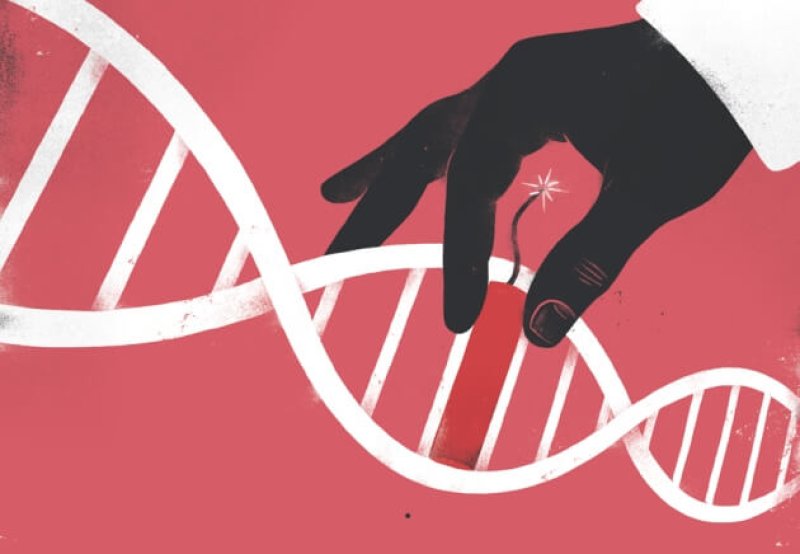A new study, published in Nature Biotechnology, investigates the use of CRISPR/Cas9 to make simple cuts in DNA in mouse cells and subsequent on-target mutagenesis due to the inaccuracy of the type of DNA repair process employed. [The study suggests that CRISPR may not be as precise as previously thought.]
Dr Helen O’Neill, Programme Director, Reproductive Science and Women’s Health, University College London, said:
…
“Of course, when assessing a new technology like this, a multitude of variables need to be accounted for; cell type, the intended DNA cut, the guides used to locate this genomic cutting site and, quite importantly, the choice of molecular scissors, of which there are many. Cas9 was the chosen molecular scissors in this study and while different cell types were analysed, the genetic architecture of cells in vitro (in a dish), will never truly reflect their behaviour in a body (in vivo).
…
“It is well understood that sufficient sequencing would take place prior to the introduction of this technology clinically, but this paper should encourage researchers to thoroughly analyse their intended editing.”
Dr Christophe Galichet, Senior Laboratory Research Scientist at The Francis Crick Institute, said:
“The data produced in the paper are very sound and well supported. However, one can wonder how the type of mutations describe in the paper, some of which being large deletions, were missed in previous studies…Previous studies have analysed the extent of unwanted mutations when using Crispr/Cas, using whole genome sequencing or other methods, and did not find evidence of off-target mutation or large DNA deletions/ insertions.
…
“The paper does not remove the validity of the use of Crispr in clinical and non-clinical studies. A greater understanding of the Crispr/Cas9 system outcomes will lead to a safer use, as we will know what to expect. In non-clinical studies, where research animals are used, specific genetic mutations are selected for and thus deletion/insertion/chromosomal rearrangement which could be misread as wildtype allele, like described in the paper, will be discarded.”
Prof Robin Lovell-Badge FMedSci FRS, Group Leader, The Francis Crick Institute, said:
“It is hard to know whether the few results in this short paper are significant or not. The authors claim that they find unsuspected DNA damage associated with the use of “CRISPR” genome editing (Cas9 and gRNAs). This has been seen before, albeit rarely, and is obviously something that would need to be checked in any clinical application of the methods. The authors suggest that these alterations in DNA, which tend to be at or close to the target site, occur at much higher levels than anticipated. The paper is technically very sound – indeed the work is of high quality. However, it is not at all clear that the specific protocols used in the paper would relate much to any sensible use of genome editing clinically.
…
“In conclusion, this paper highlights the need when conducting experiments involving genome editing, and particularly for clinical applications, to verify that the alterations to the DNA sequence are those, and only those, that had been designed to occur. This has always been obvious. But the results give no reason to panic or to lose faith in the methods when they are carried out by those who know what they are doing.”
Dr Francesca Forzano, Consultant in Clinical Genetics and Genomics, Guy’s & St Thomas’ NHS Foundation Trust, said:
“This important work demonstrates that this technique is much less safe than previously thought, and suggests that the techniques previously used to monitor the efficiency and safety of CRISPR/Cas9 exploitation were not entirely adequate.
…
“This is a good quality research piece. Results fit to the existing evidence and brings new data and robust evidence regarding a collateral damage of this technique. The data will have a great impact in this field, as it suggests different techniques for monitoring on and off site effects should be used. They also demonstrate that this technique can be less safe than previously anticipated. Researchers should take this work into account when looking into clinical applications using this technique.”
Dr Lydia Teboul, Head of Molecular and Cellular Biology at the Mary Lyon Centre, MRC Harwell Institute, said:
“This is the recognition that we still have to learn a lot about the system (which has only been used for a few years) and just as importantly about the way cells repair cuts in their DNA. The technology still holds great promises for our developing therapeutic strategies that involve making genetic changes in cells and tissues. With these important studies we are learning about the precautions that we will need to take as we use the powerful genome editing tools for therapy.”
Read full, original post: Expert reaction to study looking at deletions and rearrangements due to the CRISPR/Cas9 genome editing technique































